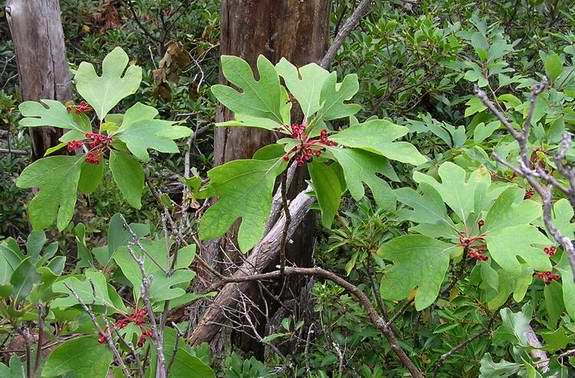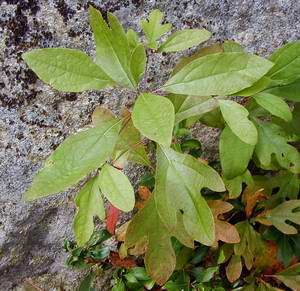|
Return to Hiker's Notebook Home Page
Common Name: Sassafras, Saxifrax, Ague tree, Gumbo file, Mitten tree, Saloop - The common name sassafras is the name of the genus to which the plant belongs.
Scientific Name: Sassafras albidum - The generic name is generally ascribed to a Spanish rendering of the name for the saxifrage, a plant normally found in rock crevices (saxum is Latin for a 'rock' and frangere is Latin for 'break in pieces'). However, there is not any logical connection between the saxifrage and the sassafras; it is more likely that sassafras is from a Native American name for the plant that sounded like saxifrage. The species name albidum is the Latin word for 'white.'
Sassafras is integral to the early colonization and exploration of North America, as it was one of the first indigenous plants thought to possess healing powers sufficient to promote a profitable export trade. The name is attributed to Nicolas Bautista Monardes, a Spanish physician and botanist who catalogued the plants of the New World in a three part tome Historia medicinal de las cosas que se traen de nuestras Indias Occidentales. Monardes is believed to have learned of the plant from Ren� de Laudonni�re, the leader of a French colony for Huguenots established at Fort Caroline on the St. John's River near present day Jacksonville, Florida in 1564. According to Monardes' writings, he learned that "the Frenchmen, which had been in Florida at that time, when they came in to those parts, they had been sick the most of them, of grievous and variable diseases, and that the Indians did show them this tree and the manner how they should use it." The Spanish attacked the French colony in 1565 from their newly established base at St. Augustine and massacred about 200 colonists, putting an end to the French incursion (Ren� de Laudonni�re escaped). Monardes probably originated the notion that sassafras was a panacea, recommending it "for them that bee (sic) lame and them that are not able to goe (sic)."
Sassafras was the cynosure for the first two English settlements in New England. Bartholomew Gosnold and 32 cohorts set sail from Falmouth, England in 1602 on the Concord with the intention of harvesting sassafras, then selling in London for 20 shillings a pound. Gosnold is credited with naming Cape Cod for the profusion of the toponymic fish in its waters and Martha's Vineyard for his oldest daughter who had died four years earlier in 1598 and for the many wild grapes that grew there. A fortified settlement was established on Cuttyhunk Island in Buzzard's Bay only to be abandoned about a month later due to the Indian threat and lack of provisions. The Concord returned to England with a cargo of sassafras and cedar. In 1603, Martin Pring followed with over 40 intended colonists on the Speedwell and the Explorer under the aegis of Sir Walter Raleigh, who held the royal patents to the region then known as Northern Virginia. After exploring the Piscataqua River that now forms the Maine-New Hampshire border in search of sassafras, the party established a colony on Cape Cod where the Gosnold expedition had been successful. There they built a stockade which was also soon abandoned presumably due to the daunting challenge of the wilderness. They returned to England after having harvested sassafras with which they filled the holds of the ship. The Pilgrims returned for a different reason 17 years later to establish the first permanent English colony in New England. Sassafras also figured prominently in the first successful English colony in the Americas. Captain John Smith, the leader of the Jamestown colony wrote in his journal that "the Indians helped the settlers dig and carry sassafras root."
Syphilis was first manifest as a disease in Europe in the sixteenth century. The origins of the disease have been subject to considerable debate ever since. The name syphilis was coined in 1530 by Girolamo Fracastoro, an Italian scientist and pioneer of epidemiology who popularized it in the book On Syphilis, or the French Disease in which the scourge is attributed to the blasphemy of the mythical shepherd Syphilis. Recent archaeological work on exhumed pre-Columbian skeletal remains has validated that syphilis originated in the New World; many bones from the Americas have been found with the tell-tale lesions of the disease whereas none have been found in Europe (one Czech study examined 10,000 skeletons). The operative theory is that the sailors of the several voyages of Columbus contracted the disease and brought it back to Spain. Charles VIII of France subsequently invaded Italy in the late 15th Century with a pan-European mercenary army of thousands and eventually besieged Naples, which was defended by Spaniards. When the war was over, the army was demobilized with the new and mysterious affliction initially called "the Great Pox" spread throughout Europe. Due to its provenance in Naples or France, syphilis has variously been known by the epithets the "Neapolitan Disease" or the "French Disease."
The scourge of syphilis motivated a frenetic search for a cure, and the New
World plant named sassafras that had just been identified as a potent medicine
by Monardes seemed a likely candidate. This nexus was likely motivated by the
Doctrine of Signatures, a
numinous belief of the late Middle Ages that God had provided a "signature"
or sign to indicate the purpose of the plants that He provided for man's use.
In this context , the sign would be that
Sassafras was and is a beneficent herb with curative properties; Monardes was correct in principle if not in degree. Native Americans, notably the Cherokee, Choctaw and Chippewa, used the bark and the roots for many maladies that ranged from curing colds and fevers to alleviating heart and blood pressure problems, generally decocting it in what was to become a popular beverage called sassafras tea. The medicinal properties extolled by Monardes and sought after by English explorers led to its prescription for many deleterious conditions. John Gerard, the noted English herbalist wrote in 1597 that " the roots of sassafras hath power to comfort the liver, to comfort the weake (sic) and feeble stomach, stay vomiting, and make sweet the stinking breath." The Pilgrims of the Massachusetts Bay Colony called it the "ague tree" and used it to treat fever and rheumatism. Sassafras was listed in the Pharmacopoeia Londinensis as early as 1618 and subsequently in the U. S. Pharmacopoeia from 1820 to 1926. In general usage, sassafras tea was used as a "spring tonic" that would cleanse the body of ill humors and promote physical and mental well being. It was thought to balance body hormones and to stimulate the liver in its removal of toxins from the blood and therefore ameliorate skin diseases such as psoriasis and eczema.
The distillate of sassafras bark and root is a heavy, volatile oil called sassafras oil that consists primarily of safrole (p-allylyn ethylenediozybenzene) which imparts its pleasant taste and aroma. Other constituents include 5-menthoxyeugenol, asaron, coniferaldehyde, and camphene. The oil has been used in the manufacture of perfume and soap for its aromatic properties and in the manufacture toothpaste and chewing gum for its taste. The original flavoring for root beer is the oil of the sassafras root. Sassafras leaves are dried and crushed into a powder called fil� that is used as an additive to thicken sauces and soups called fil� gumbos in Cajun and Creole cooking. A hot beverage called saloop is also made from the leaves. Research conducted in the 1960's revealed that safrole caused cancer in laboratory rats. Sassafras bark and oil were banned by the FDA for flavoring or food additives in 1976. Most commercial root beers now use methyl salicylate from the black birch (Betula lenta) as a flavoring agent. Additional research revealed that, while safrole has some properties that reduce skin irritation, it has no other significant medicinal benefits |

 God
created the disease called syphilis in the New World for a reason that only
theodicy could justify, and that that he collocated its antidote as a
palliative measure. A second possible reason for the syphilis-sassafras
linkage is that the priapic shape of the sassafras leaves was thought to be a
divine signature for the treatment of genitally related malady. The leaves are
certainly noticeable; in addition to the unique tri-lobed primary shape, the
same tree will also have leaves with a single lobe, like a mitten (hence the
name " mitten tree") and leaves that are entire. Once it became general public
knowledge that sassafras was a treatment for syphilis, it fell from favor
among the English gentry and the sassafras craze that had fueled the
settlement of the English colonies abated.
God
created the disease called syphilis in the New World for a reason that only
theodicy could justify, and that that he collocated its antidote as a
palliative measure. A second possible reason for the syphilis-sassafras
linkage is that the priapic shape of the sassafras leaves was thought to be a
divine signature for the treatment of genitally related malady. The leaves are
certainly noticeable; in addition to the unique tri-lobed primary shape, the
same tree will also have leaves with a single lobe, like a mitten (hence the
name " mitten tree") and leaves that are entire. Once it became general public
knowledge that sassafras was a treatment for syphilis, it fell from favor
among the English gentry and the sassafras craze that had fueled the
settlement of the English colonies abated.